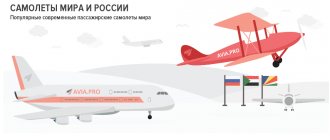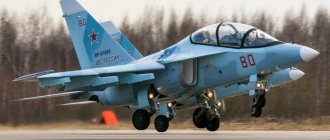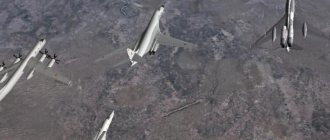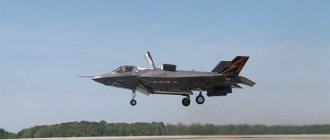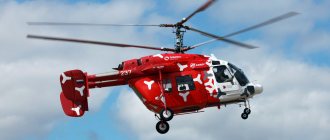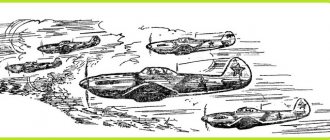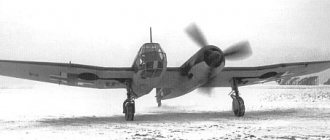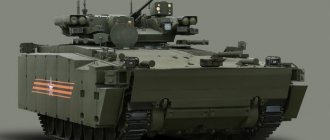The Su 30SM aircraft occupies a worthy place in the model range of Soviet jet fighter aircraft. Despite its venerable age (the machine was created in the late 80s of the 20th century), the Thirtieth Drying Machine is still considered a mature, modern and combat-ready machine today. In all its flight and military-technical characteristics, the newest Russian aircraft is considered a 4+ generation fighter, capable of adequately resisting any potential enemy in the air.
Su-30 Dimensions. Engine. Weight. Story. Range of flight. Service ceiling
To combat enemy cruise missiles, the Russian Air Force needed a two-seat long-range fighter. The potential combat capabilities of the Su-27 fighter were clearly not enough. The design bureau decided to use as a basis the two-seat Su-27UB, the serial production of which was mastered at the Irkutsk aircraft plant. Work on the aircraft began in 1986. During the testing of the experimental Su-27UB, the in-flight refueling system was already tested on it. On the starboard side, at the level of the canopy canopy, an L-shaped fuel receiver rod was installed. On the modernized “spark”, called the Su-27PU, the living conditions in the cockpit were also somewhat improved.
Start of development
It all started back in 1994, when negotiations were held with India on the supply of Su-27 fighters. Even then, the Indians hinted that they would not mind purchasing even more maneuverable aircraft, and the Russian army urgently needed new aircraft.
But the need for new technology was dictated not only by export needs. The main reason why the Su-30 SM aircraft appeared, a photo of which you will find in our article, is the incomplete realization of the potential that was put into the simple “thirty” by its creators.
The possibility of massive destruction of ground targets was seen as particularly promising: a vehicle “carrying” two pilots at once, with good “autonomy” and flight range, and even carrying eight tons of ammunition, definitely had excellent prospects of becoming the main strike force of the domestic air force.
Design of the new fighter began in 1995. The chief designer of the project is A.F. Barkovsky. In 1996, a contract was already signed with India for the supply of 40 new vehicles of various classes. It was assumed that export batches would come with a gradual improvement in the tactical and technical properties of the aircraft. The executors of the State order are various enterprises of the Sukhoi holding, the head department is the Irkutsk Aircraft Plant.
Su-30 - video
At the beginning of 1987, the first flight of the converted “spark” took place with a crew consisting of OKB test pilots I. Votintsev and N. Sadovnikov. On June 23, a non-stop flight T10U-2 with the same crew took place on the route Moscow - Komsomolsk-on-Amur - Moscow with a length of 13,440 km and a duration of 15 hours 42 minutes with four refuelings in the air. Thus, the possibility of using the modernized Su-27UB as a long-range fighter-interceptor was demonstrated. The aircraft received an in-flight refueling system, a new navigation system, and an upgraded remote control and weapons control system. The first of two pre-production Su-27PU aircraft (T10PU-5) took off on December 31, 1989 from the factory airfield of the Irkutsk aircraft plant. Based on the results of flight tests of the modernized machines, serial production of a two-seat fighter began, designated Su-30. Externally, the Su-30 differed from the combat training Su-27UB by the presence of a retractable fuel receiver rod on the left side and the fairing of the optical location head being shifted to the right. On April 14, 1992, the first production fighter Su-30 made its first flight.
The OKB, together with IAPO, created an export version of the Su-ZOK (“K” - commercial) aircraft, which received expanded capabilities for operations against ground targets. A further development was the Su-ZOMK aircraft with an improved radar and a significantly expanded range of weapons. When creating it, the experience of developing the Su-35 fighter was used. The Su-ZOMK is designed to gain air superiority in a theater of military operations, as well as destroy targets on land and at sea, using electronic warfare systems and anti-aircraft fire, day and night, in all weather conditions. Work on the creation of the Su-ZOMK began in 1991, and the prototype of this aircraft made its first flight on April 14, 1992 (test pilots G.E. Bulanov and V.B. Maksimenkov). Externally, it was practically no different from the Su-30. In the rear cockpit there is an indicator on which video information from the television homing heads of guided weapons can be displayed. The Su-ZOMK fighter has unique combat capabilities that place it in first place in the world among heavy serial multi-role fighters.
On November 30, 1996, a Russian-Indian contract was signed for the purchase of 40 Su-30MKI aircraft (index “I” - Indian). On July 1, 1997, this aircraft took off for the first time. The aircraft is made according to the “longitudinal triplane” aerodynamic configuration, with a thrust vector control system (TCV) of the engines, combined with an aircraft remote control system (RCS), which provides virtually unlimited maneuverability and unique takeoff and landing characteristics. The radar is capable of simultaneously tracking up to 10 targets and firing missiles at two targets at once.
A mark on aviation history and gaming
The Su-30 became the ancestor of modified versions of the fighter, which are produced to this day. According to information from 2016, the Russian Aerospace Forces have the following models in its fleet: Su-30 (3 units), Su-30M2 (16 units), Su-30SM (39 units). The Black Sea Fleet has 8 Su-30SM fighters. 5 Su-30SM aircraft are deployed in Crimea. The Su-30 M2 aircraft was created on the basis of the Su-30MK2 export aircraft. The fighter is equipped with high-precision weapons.
The creators of electronic games did not ignore the Su-30 either. By controlling a flight simulator, you can perform combat missions and make your imaginary contribution to the fight against terrorism. The most popular game is called SU-30. Judging by the description and user reviews, the features of naturalized controls allow us to give the shooter the highest rating among other analogues. There are also mobile versions - scrolling shooters SU-30.
The Su-30 fighter was produced during the collapse of the USSR.
Despite the lack of funding, aircraft designers created another masterpiece for Russian aviation. For more than 25 years, various modifications of the combat "Sushka" with an index of 30 have been in combat service with the Russian Air Force and more than 10 other countries.
A series of disasters from 1999 to 2022 did not at all spoil the aircraft’s reputation. In most cases, the cause of accidents was human factor or force majeure. For example, the last plane crash on May 3, 2018, occurred due to a bird hitting the power plant (according to the official version). Unfortunately the pilots died. But cases with tragic outcomes are rare.
Performance characteristics of the Su-30
— First flight: 1989 — Years of production: since 1992 — Units produced: about 600 (as of November 2022)
Cost of Su-30
- $83 million (Indian-assembled Su-30MKI, 2012) - $50 million (Su-30SM for the Russian Air Force, 2012)
Su-30 crew
— 2 people
Dimensions of the Su-30
— Length: 21.9 m — Wing span: 14.7 m — Height: 6.36 m — Wing area: 62 m² — Wing load at normal take-off weight: 398 kg/m² — Wing load at maximum take-off weight: 532 kg/m²
Su-30 weight
— Empty weight: 18800 kg — Normal takeoff weight: 24900 kg — Maximum takeoff weight: 34500 kg — Maximum takeoff weight: 38800 kg — Fuel weight: 9640 kg
Su-30 engine
— 2 × AL-31F turbofan engines (AL-31FP on Su-30SM) — Maximum thrust without afterburning: 2 × 7770 kgf — Thrust with afterburner: 2 × 12500 kgf — thrust vector deflection angles (for AL-31FP): ±16 ° in any direction, ±20° in the plane - thrust vector deflection speed (for AL-31FP): 60°/s - weight: 1520 kg
Maximum overload: +9 G
Su-30 speed
— Maximum speed at the ground: 1350 km/h (M=1.13) — Maximum speed at altitude: 2,350 km/h (M=1.9603)
Su-30 flight range
— near the ground: 1270 km — at altitude: 3000 km — combat radius: 1500 km — Flight duration: 3.5 hours (without refueling)
Su-30 service ceiling
— 17300 m
Su-30 takeoff speed
— 13800 m/min (230 m/s) — Run length: 550 m — Run length: 750 m
Thrust-to-weight ratio of the Su-30
— at normal take-off weight: 1.00 — at maximum take-off weight: 0.84 — at maximum take-off weight: 0.76
Armament of the Su-30
— Cannon: 30-mm built-in cannon GSh-30-1 — Suspension points: 12 — Combat load: 8000 kg (up to 10.4 tons according to the RLE). - 6 medium-range guided missiles R-77, R-27R or R-27ER, R-27T or R-27ET with TGS and 6 close-in missiles R-73 with TGS; — Free-falling bombs weighing 500 kg (up to 8 units) or 250 kg (28 units); — KMG-U containers (up to 7 units) or NAR S-13 and S-8 units (up to 4 units); — Various combinations of guided and unguided weapons of various classes are possible.
Experimental specimens
The first two Su-30 SM, the characteristics of which you will find in the article, were built between 1995 and 1998. The first machine, created on the components of the standard Su-30, took off in 1997. Experienced tester V. Yu. Averyanov was at the helm. From the middle of that year, a large-scale program began to test and fine-tune new machines in order to prepare for their mass production. It started in 2000. At the same time, the first pre-production fighter was tested by Averyanov. Based on the results of these tests, three prototypes were transferred to the Design Bureau for planned research and modernization.
Why were imports so important?
If you carefully read our article, then you may well have an absolutely logical and logical question: why is the Su-30 SM, whose technical characteristics are so good, constantly being considered in terms of foreign deliveries? The answer, oddly enough, is simple. At a time when the aircraft manufacturing industry was far from being in its best condition, the state still managed to load the same Irkutsk aircraft manufacturing plant. This means not only providing jobs for thousands of people, but also ideally “polished” production technology.
After all, the Su-30 SM aircraft, the characteristics of which we reviewed, has been in mass production for more than 15 years! At the same time, the machine, due to its enormous potential in the field of modernization, remains quite relevant today. Considering that these fighters have begun to enter service with the Russian Air Force in more or less adequate quantities, one can only be happy for the pilots: they are getting at their disposal not a “raw” prototype, but a completely logical system brought to constructive perfection.
Finally, the entry into the troops really suggests that the army is interested in training new pilots who will subsequently master the T-50 PAK FA. Considering the extremely unstable geopolitical situation in recent years, this is indeed an important circumstance.
International recognition
The authority of this aircraft was difficult to earn. According to many foreign experts, the collapsed Russian defense industry simply physically could not produce anything worthwhile, and therefore initially the interest in our technology was dismissive and skeptical. But everything changed after several international exercises. At that time, many realized that they had greatly underestimated the Russian aircraft. However, some experts turned out to be more perspicacious: when they received information about the modernized Su-27s, which were also supplied to India, they spoke highly of the characteristics of this machine.
Even these machines, the improvement of which resulted in the Su-30 SM aircraft, whose performance is much better, managed to establish themselves as reliable and high-quality military equipment. After this, the high command of the Indian Air Force decided that the level of their pilots was quite sufficient for them to measure their strength with American pilots. This happened during the Cope India 2004 exercises, when the US F-15Cs became opponents of the Indian Su-30 SM, photos of which are in the article.
Other facts
The results somewhat discouraged supporters of American technology. Thus, the superiority of the new technology in close combat turned out to be quite predictable, since domestic aircraft, in principle, are much more maneuverable than the old F-15s. Much more surprising was the fact that the Indian pilots were the winners even in those cases when it came to medium-range battles.
This was largely due to the fact that the Su-30 SM (photos presented in this material) have more advanced systems that allow them to detect and track several targets at once. Therefore, it is not surprising that immediately after those epoch-making exercises in the United States, supporters of the immediate development of the new F-22 Raptor became more active.
